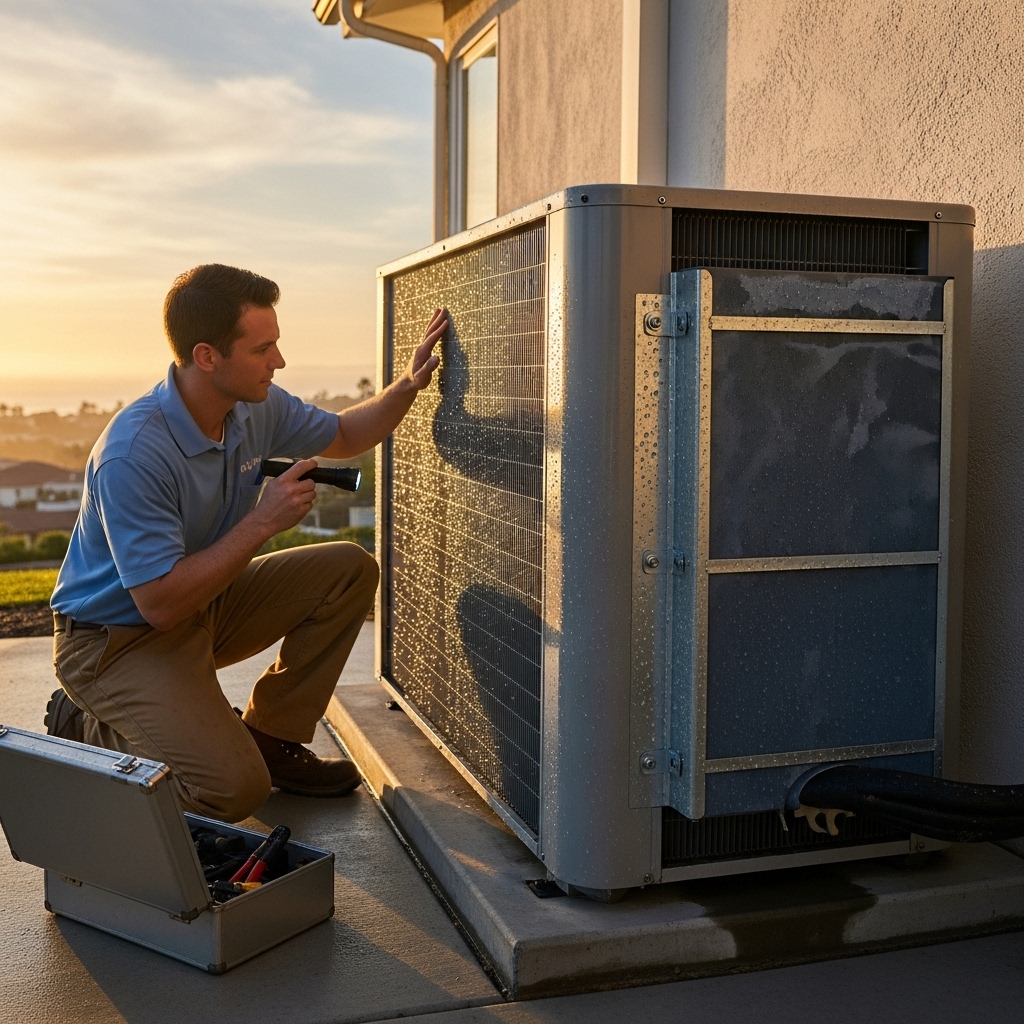Beverly Hills is a place where climate shifts are as much a part of daily life as the tide. Mornings can be wrapped in a cool marine layer, afternoons glow under broad sun, and a Santa Ana wind can change the script entirely. In this setting, home cooling systems do much more than chase heat; they manage humidity, filter smoke, and quietly resist the slow pressure of salt air. Over the years, I have seen patterns in the kinds of issues coastal homes face and the fixes that work. When you understand how the coast shapes equipment performance, you can prevent many headaches and respond faster to the ones that appear. If you are new to coastal ownership or simply want your system to run better, knowing how air conditioning behaves in Beverly Hills is a practical starting point.
One of the defining forces here is salt. It drifts in on breezes and settles invisibly on outdoor equipment. Over time, salt invites corrosion and can form a faint film on condenser coils that reduces their ability to shed heat. When the coil cannot reject heat well, pressures rise and the unit labors, especially on hotter afternoons. You may notice longer runtimes or warmer air from the vents despite the system working hard. The fix begins with prevention: coastal-rated equipment, protective coatings, and strategic placement out of direct salt spray. For homes already in service, regular rinsing of outdoor coils with gentle water pressure and an eye for corroded fasteners can recover lost performance and extend lifespan without drama.
Humidity and the Marine Layer
The marine layer brings cool temperatures but carries moisture that can stress systems in different ways. Indoors, humidity can leave rooms feeling clammy even if the thermostat reads a comfortable number. The wrong response is to keep lowering the temperature, which overcools without truly solving the moisture problem. In Beverly Hills, equipment that can slow its fan and prioritize moisture removal makes a noticeable difference. If your home always feels damp in the morning, your air handler may be moving air too quickly, not giving the coil a chance to wring out moisture. Adjustments to fan speed, upgraded controls that include a “dehumidify” or “dry” mode, or adding a dedicated dehumidification function can shift the experience from chilly-damp to comfortably dry without needless cooling.
Clogged and Algae-Prone Drain Lines
Where there is moisture, there is a path for algae. Condensate drain lines collect the water that forms on the indoor coil and carry it away. In long periods of damp weather, algae growth can clog the line and trigger safety switches that shut the system down to prevent overflow. If your system suddenly stops and a drip pan is damp or the float switch has tripped, a clogged drain is a likely suspect. Routine maintenance that includes clearing and treating the drain line prevents this. Good installers also build in cleanout points, making service straightforward. Keeping an eye on areas near the coil for signs of moisture goes a long way toward preventing surprises.
Filter Issues in a Coastal-Wildfire Reality
Filters do heavy lifting here. During wildfire smoke days, they load up quickly. During high pollen periods, they work even harder. A filter that was clean two months ago can be overwhelmed after one bad smoke event. Symptoms include reduced airflow at the registers, hotter-running equipment, or a whistling return grille as the system strains to pull air through a dense filter. The solution is simple but essential: check filters more often during challenging air quality periods, and choose a filter that balances capture efficiency with airflow the system can handle. A well-sealed return path is just as important; if gaps let the system pull air from attics or garages, you are losing performance and introducing contaminants you would rather avoid.
Duct Leaks in Older Homes and Additions
Beverly Hills’s charm includes homes built across decades, often with additions stitched on to meet changing needs. Duct systems can reflect that history. Leaks in ductwork waste cooling by letting conditioned air escape into attics or crawlspaces. They also draw dusty, unconditioned air into the system through return leaks, adding to filtration work and indoor air quality concerns. If you notice uneven temperatures between rooms, high dust levels, or a system that never seems to catch up on hot days, duct leakage may be part of the story. Pressure testing and professional sealing restore lost capacity and create a more even, quiet cooling experience throughout the home.
Refrigerant Leaks and Performance Drift
Small refrigerant leaks can escape notice until they accumulate into a real performance problem. You might observe longer runtimes, ice on the refrigerant lines, or a cooling that feels dull rather than crisp. In coastal areas, corrosion can affect brazed joints or exposed components over time. The right approach includes locating the leak with proper testing, repairing it, and weighing in the correct refrigerant charge. Running a system undercharged strains components and can snowball into compressor issues. Catching and correcting a leak early restores efficiency and helps preserve equipment life.
Wind Effects and Noisy Outdoor Units
On bluffs and open oceanfront lots, steady wind can make outdoor units sound different than they do inland. Wind passing through the condenser fan can create tones or cause the fan to work harder. In some positions, wind can recirculate hot discharge air back through the coil, reducing performance. Solutions range from subtle wind screens that maintain clear airflow to repositioning equipment slightly, or adding manufacturer-approved baffles. The goal is to preserve free, cool intake air around the condenser while shielding it from relentless direct wind that disrupts normal operation.
Thermostat and Control Quirks
Smart controls are a gift when used well, but settings that clash with real-world use create odd behavior. A schedule that drives the temperature down when the home is empty or fights Beverly Hills’s daily humidity swings can waste effort. If you see the system cycling frequently, or if rooms feel cold and damp before settling, look at how your control strategy handles dehumidification and fan speed. Many modern thermostats allow you to set humidity targets, fan profiles, and temperature bands that reduce overshooting and keep the system in its quiet, high-efficiency range. In multi-zone homes, ensuring sensors are placed in representative areas—not in direct sun or in drafts—prevents false readings that lead to poor comfort decisions.
Condensers Near the Ocean and Finish Failures
It is common to place outdoor units where they are out of sight, yet those tucked-away corners can collect salty air without relief. Over months and years, finishes can dull and hardware can oxidize. Protective equipment coatings and stainless fasteners help, but so does placement where breezes dilute salt before it rests. If you see early signs of finish wear or rust, it is a cue to review both maintenance and siting. A small relocation can make a big difference in how gracefully a system ages, and it often reduces noise in the spaces you care most about.
Uneven Rooms: Glass, Sun, and Microclimates
Rooms with vast west-facing glass—common in Beverly Hills for obvious reasons—can heat quickly late in the day. If your system is not zoned, these rooms often dictate the entire home’s set point, pulling cooler temperatures everywhere just to keep the view-side room comfortable. The fix can be as involved as adding a dedicated zone or as simple as tuning diffuser placement and air volumes to favor the late-day hot spots. Interior shading and improved glazing can reduce load dramatically so the overall system runs steadier and quieter.
Maintenance as Prevention
Most of the issues I see are less dramatic when maintenance is routine. Outdoor coil rinsing to remove salt film, drain line care to prevent algae, filter checks during smoke and pollen waves, and a review of duct integrity keep the system out of trouble. Think of it as caring for a finely tuned instrument in a beautiful but demanding environment. The result is fewer surprises on the hottest week and a home that stays as calm inside as it looks outside.
When Smoke Blows In
Wildfire smoke changes the way we use cooling. Doors and windows that are often open stay shut, and the system becomes the gatekeeper of indoor air quality. If the air turns sour and visibility softens, switch to recirculation and allow the system to filter indoor air repeatedly. Upgraded media filters and sealed returns earn their keep on these days. Once the smoke clears, airing out the home and returning to normal ventilation patterns resets the space without lingering odors.
Mid-Course Corrections for Better Comfort
Sometimes the fix is not a repair but a recalibration of how the system is used. A common example is setting the thermostat too low to chase humidity, which wastes energy and creates cold, damp interiors. Another is running the fan continuously in foggy weather, which can re-evaporate moisture from the coil and send it back into the home. Understanding how modern air conditioning balances temperature and moisture helps you make small changes that feel big in daily life.
Frequently Asked Questions
Why does my coastal condenser look dull so quickly?
Salt air accelerates finish wear and metal oxidation. Even without visible salt spray, a fine film builds up and holds moisture. Coastal-rated equipment, protective coatings, stainless fasteners, and periodic fresh-water rinses slow this process. Placement that avoids direct exposure to wind-borne salt also extends the fresh look and performance of outdoor units.
Is it normal for my home to feel humid in the morning?
Along the Beverly Hills coast, yes. The marine layer carries moisture that raises indoor humidity, especially in homes that are opened to the breeze. Systems with variable-speed fans and controls that prioritize dehumidification can remove moisture without overcooling. If mornings feel clammy, ask about adjusting fan profiles and set points to favor moisture removal.
How often should I change filters during wildfire season?
More often than usual. Heavy smoke loads filters quickly and can starve the system of air, reducing performance and stressing components. Inspect filters after significant smoke events and replace as needed. Choose a filter with a rating your system can handle so airflow remains within design, and verify the return path is sealed to keep unfiltered air out.
Why is one room always warmer in the afternoon?
Late-day sun through west-facing glass can overwhelm a space. Without zoning, that room can dictate the whole-home set point. Targeted shading, improved glazing, diffuser adjustments, or adding a zone for that space can even out temperatures. The right solution depends on layout, exposure, and how you use the room.
My system stopped and there’s water near the air handler—what now?
It could be a clogged condensate drain triggering a safety switch. In moist conditions, algae grows and can block the line. Clearing and treating the drain is part of routine care. If the issue recurs, adding a cleanout or reviewing drain slope and run length helps prevent future shutdowns.
Does a smart thermostat help in Beverly Hills?
It can, especially if it supports humidity targets and variable-speed control. Scheduling, occupancy sensing, and remote access make it easier to match system behavior to real life—cooling only the rooms you use, when you use them, and maintaining a drier feel during marine layer mornings.
When should I suspect a refrigerant leak?
If you notice ice on refrigerant lines, longer runtimes, or weaker cooling, have the system checked. Coastal corrosion can affect joints over time. Proper testing to find and repair the leak, followed by charging to manufacturer specs, restores performance and prevents larger failures.
Ready to solve your Beverly Hills cooling challenges?
If your system is struggling with salt, humidity, or uneven rooms, a focused plan can restore calm comfort. Explore options for modern air conditioning and tune your home for the realities of coastal living, from foggy mornings to warm, sunlit afternoons.

